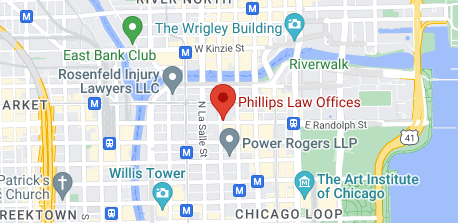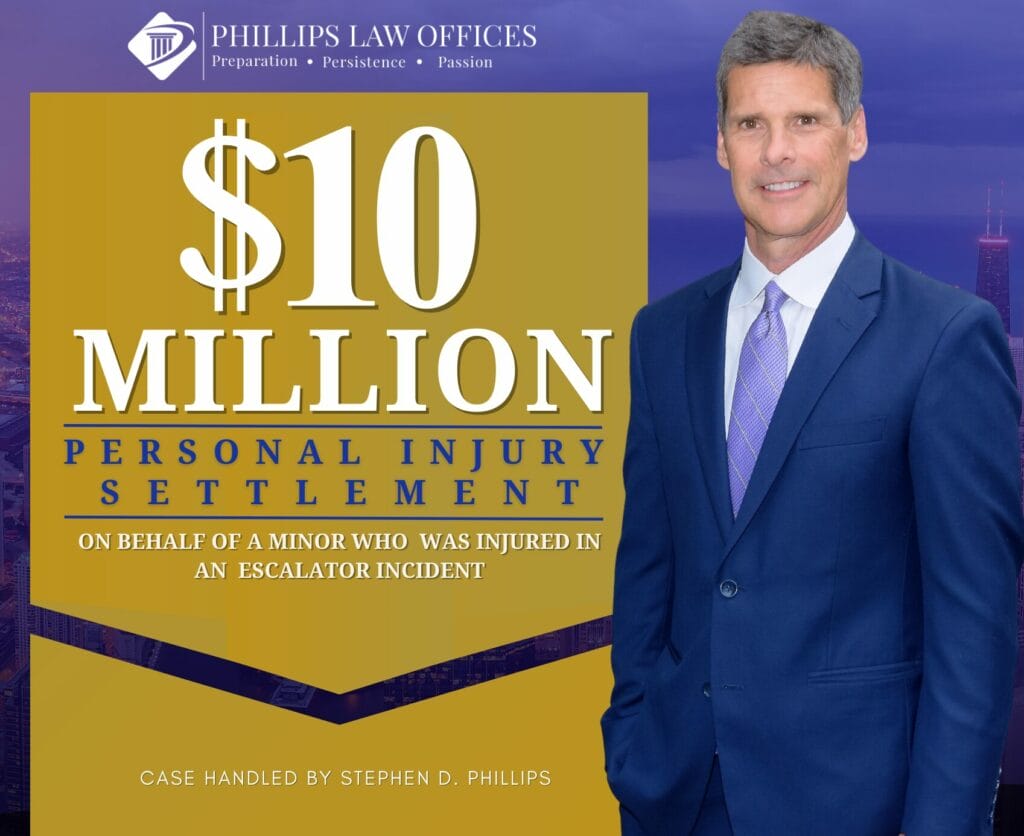A bone fracture is a partial or complete break in a bone brought on by external forces. It is a common injury type caused by different accidents happening inside the boundaries of Chicago. These injuries range from minor hairline cracks to complex fractures with multiple breaks and displacements. Car crashes, slips and falls, sports injuries, and playground accidents are some of the common causes. Any bone in the body, including those in the arms, ankles, wrists, legs, and hips, is susceptible to fractures. Treatment options include manipulation to realign the alignment and immobilization with casts or splints. In extreme cases, surgical intervention with pins, plates, or screws is essential to stabilize the fracture and facilitate quick healing. You me need a lawyer if incident was happened because of others mistake.
Severe or improperly healed bone fractures can permanently impair bodily motion and generate hefty medical bills. If you have suffered a bone fracture due to someone else’s negligence, our experienced Chicago bone fracture lawyer from Phillips Law Offices can assist you in seeking compensation. We can gather evidence, determine liability, negotiate with insurance companies, or file a lawsuit based on your interest.
Types Of Common Bone Injuries
When it comes to fractures, bone injuries occur in various ways, and not all are the same. Bones can break lengthwise, crosswise, or in multiple pieces. Based on its severity, there are several types of bone fractures, such as:
Transverse fracture
In this fracture, bone breaks horizontally due to direct force or trauma. Since the break occurs perpendicular to the long axis of the bone, it results in two straight bone fragments. Treatment for this straight-line bone fracture may involve realignment and immobilization of the bone with splints, casts, or surgical intervention.
Spiral fracture
When a bone breaks in a spiral pattern due to a twisting or rotational force, it is a spiral fracture. It generally happens because of excessive rotational or torsional stress on the bone. Depending on the severity and location, surgical intervention and immobilization may be necessary for spinal fractures.
Oblique fracture
A diagonal or slanted break across the bone is a defining feature of an oblique fracture. It forms an angle pattern rather than a straight line. These fractures can be unstable and necessitate surgery to stabilize and align the bone for proper healing.
Avulsion fracture
An avulsion fracture is a bone fracture in which a tendon or ligament pulls a small piece of bone away from the primary source. Usually, a sudden, forceful contraction of the attached muscle causes it to happen. In most cases, surgery or immobilization is vital for reattaching the broken bone fragment.
Comminuted fracture
The bone shatters into three or more fragments in comminuted fracture and creates a more critical condition than others. It generally occurs because of high-energy impacts or significant trauma. These bone fractures are more complex and necessitate careful realignment and stabilization to ensure proper healing and functional recovery.
Stress fracture
This bone fracture develops gradually due to repetitive stress or overuse of a bone. It causes a small crack in the bone and severe pain. This bone condition often results from athletic activities such as running, jumping, or repetitive workouts. Athletes or individuals engaging in repetitive activities are prone to stress fractures.
Open fracture
Also called a compound fracture, this bone injury refers to a condition wherein a broken bone protrudes through the skin. Due to the severity of the injury, it necessitates immediate medical aid to avoid infection and facilitate proper healing. Treatment may involve cleaning the wound, realigning the bone, and securing it with splints or surgery.
Compression fracture
A compression fracture is a type of bone fracture that occurs in the vertebrae, where the bone collapses or becomes compressed. Osteoporosis, trauma, or repetitive stress are common causes. Symptoms include back pain, limited mobility, spinal deformity, and nerve damage. Due to its potential complications, treatment may involve pain management, rest, and surgical intervention based on your condition.
-
bone fracture
Bone Fracture Diagnosis And Care
As stated before, accidents and negligence can cause bone fractures of many types. However, its precise type and severity extent depends on forces exerted on the bone and affected body area. It is wise to seek immediate medical attention from an orthopedic specialist for proper diagnosis and treatment. A healthcare professional will examine the injured area and lookout for open wounds, swelling, bruising, deformity, or other symptoms. After a physical examination, the doctor might inquire about your general health and any existing medical conditions likely to affect your treatment options.
Doctors suggest imaging tests like X-rays for bone fractures to understand the place, type, and severity of the break. In extreme cases, they may recommend additional imaging techniques such as MRI (Magnetic Resonance Imaging) or CT (Computed tomography) scans for a more detailed evaluation. Additionally, the orthopedic doctor will assess the neurovascular condition of the affected area. They will check whether or not there is any damage in the blood vessels or nerves. This evaluation may include testing for sensations, pulses, and motor function.
The doctor will determine the fracture type based on the physical examination and imaging tests. Fractures can be closed, open, displaced, non-displaced, or comminuted. Depending on the type and severity of the fracture, the recommended treatment may include conservative measures (like casting or splinting) or surgical intervention (like internal or external fixation). For post-treatment care, the doctor will plan immobilization, pain management, physical therapy, or rehabilitation according to your condition.
What Causes Bone Injuries in Chicago, Illinois?
In Chicago, traffic collisions and falls are the two most frequent accidental injury risks that cause bone injuries. With an estimated 300,000 aging population, the state has residents of 65 and older vulnerable to falls. Generally, a broken hip is the most severe bone injury that can occur to someone in this age group. It often makes the sufferer incapable of living independently or even results in death.
Over 300,000 auto accidents occur on Chicago roads annually, including about 65,000 injury crashes. Broken bones are evident and typically happen because of excessive pressure or blow to the bone. The impact seen in most traffic accidents includes the following:
- Broken femurs from broadside collisions on the passenger side of the car
- Broken arms and wrists due to the body’s natural tendency to stiffen the arms and wrists during the collision
- Clavicle (collar bone) as a result of seat belt pressure during the collision
- Facial or skull fractures caused by collisions with the steering wheel, dashboard, or other objects
Compensation After a Bone Injury in Chicago
Not every bone injury case is similar in Illinois. As a legal claimant, the compensation you can expect depends on the specifics of your case. Generally, an individual is eligible for reimbursement for the following if negligence is proven:
Medical costs
It can cover the price of any necessary medical care for broken bones. It includes diagnostic tests, hospital stays, surgeries, physical therapy, medications, and any future expenses related to the injury.
Income loss
If you missed going to work and lost wages due to your bone injury, you can seek a claim for earning loss. It includes the amount you could have obtained during that period.
Non-economic damage
Besides economic loss, you can claim for the mental anguish caused by the traumatic bone injury. Experts can evaluate this damage, considering your physical pain, suffering, and emotional distress resulting from the fracture.
Permanent disability
In some circumstances, bone injuries result in a lifelong impairment or disability that limits your ability to work or carry out daily tasks. You might be eligible for compensation for the effects on your quality of life and potential future earnings.
Long-term rehabilitation
For long-term rehabilitation, some patients might need aids like wheelchairs, crutches, or prosthetic limbs. To accommodate your disability or impairment, you might need to install ramps or handrails in your home. You can claim for assistive devices and home modification expenses also.
The exact amount of compensation highly depends on the strength of the evidence supporting your claim. However, you can put forth a compelling case with the help of professional legal advisors. With their expertise and experience, attorneys can defend your rights and help settle at the maximum amount. They can assess the specifics of your circumstance, estimate the potential damages, and explore your legal options.
Contact Our Chicago Broken Bone And Fracture Attorney
At Phillips Law Offices, we provide unmatched client representation and care. We tend to assist in obtaining just compensation if someone else’s negligence led to an accident that broke your bone. If you suffered a bone fracture injury due to one of the following, we can represent you:
- Nursing home abuse
- Truck accident
- Product liability
- Premises liability
- Road rage accident
- Pedestrian car accident
- Train incident
- Motorcycle accident
- Distracted driving
- Crossing red light
- Driving under the influence (DUI)
- Trauma at work
We often seek reimbursement for the costs and effects of the injury through the personal injury claims process. Typically, this process starts when our attorney delivers a demand package to the at-fault party’s insurance company. This package contains information about the accident, proof of expenses, and a demand for the claimed amount. The insurance company may accept the total value after receiving and reviewing the demand package, request an adjustment, or deny your claim.
If the company acknowledges your file and pays the amount as requested, your claim gets resolved.
The problem arises when the insurance provider denies the claim or offers a low settlement sum. At this point, our attorney can bargain with the adjusters on your behalf and persuade them to accept a higher settlement. They may discuss relevant clauses and evidence supporting your claim to reach a fair amount. If the company resists, our attorney can file a personal injury lawsuit. Eventually, the court will decide the compensation you should receive for your bone injuries. So, for guidance and free, no-obligation consultation, contact us at (312) 598-0917.
Also Read:
Safe Following Distance While Driving
Delayed Vertigo after a Car Accident







